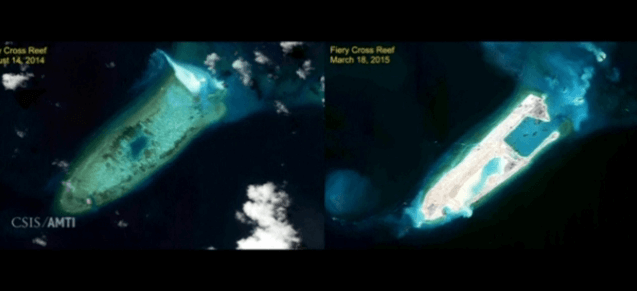Brand new satellite images published on Thursday show China has nearly completed building a military airstrip in the contested South China Sea’s Spratly Islands and is likely planning another. These hostile moves have been greeted with concern in the United States and Asia.
IHS Jane’s Defense Weekly said the March 23 pitcutres from Airbus Defence and Space showed work on the runway on reclaimed parts of Fiery Cross Reef in the Spratly Islands, which China contests with its neighbours the Philippines, Vietnam, Malaysia, Brunei and Taiwan.
The magazine said images from earlier in March showed reclamation work on Subu Reef in the Spratlys creating landmasses that, if joined together, could create space for another 3,000-meter airstrip. This length of runway is well suited to military aircraft such as fighter jets, bombers and reconnaissance aircraft.
Other images suggested China was working to upgrade another airstrip to military length in the Paracel Islands further north in the potentially energy-rich South China Sea, a vital shipping route through which $5 trillion of trade passes every year.
The troubling report comes a day after the U.S. military commander for Asia, Admiral Samuel Locklear, said China, which claims most of the South China Sea, could deploy radar and missile systems on outposts it is building that could be used to enforce an exclusion zone should it move to declare one.
Senator John McCain, chairman of the U.S. Senate Armed Services Committee, called the Chinese moves “aggressive” and said they showed the need for the United States government to act on plans to move more military resources into the important Asian region and boost cooperation with Asian countries worried by China.
“When any nation fills in 600 acres of land and builds runways and most likely is putting in other kinds of military capabilities in what is international waters, it is clearly a threat to where the world’s economy is going, has gone, and will remain for the foreseeable future,” he told a public briefing in Congress.
The latest intelligence, of which the U.S. is keenly aware of, show the need for improved force presence in the region and increased cooperation. China’s ageing population, recent slowdown in growth and convoluted governance system create conditions that are textbook precursors to a diversionary war. Regimes in such a position will often start a war over a small, insignificant piece of land to divert the attention of the population away from troubles at home and rally the country around nationalistic values.
Given China’s tight censorship of media and limited personal freedoms it has all the tools to carry out such a war successfully.
Stay Connected